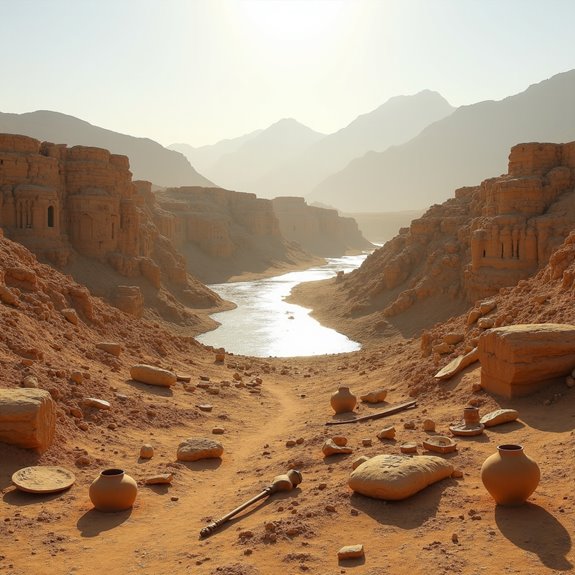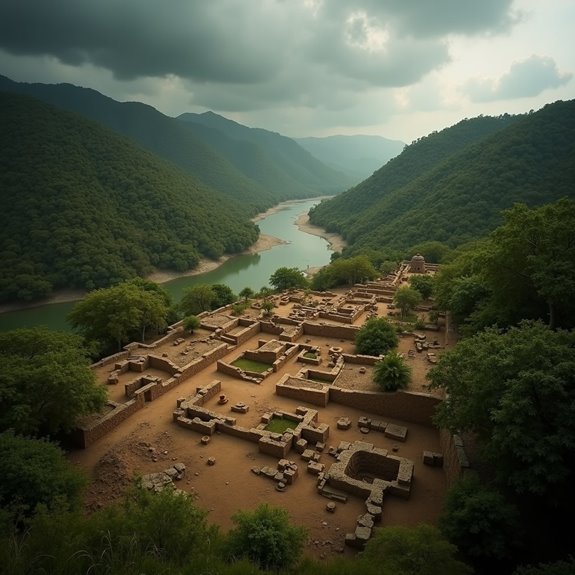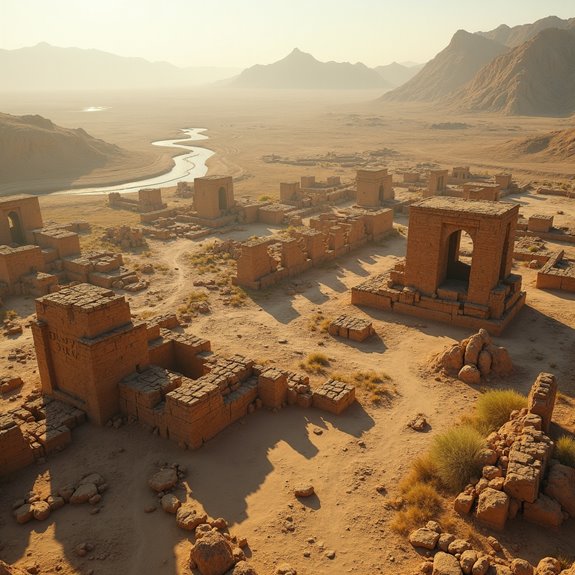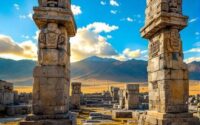What Caused the Collapse of the Indus Valley?
The collapse of the Indus Valley civilization remains a complex and debated topic among historians. Evidence suggests that environmental changes, such as shifts in monsoon patterns and tectonic activity, played significant roles. Additionally, urban overextension and potential social conflicts among city-states could have further weakened their societal structure. As scholars continue to piece together these factors, the true reasons behind the civilization’s downfall become increasingly intriguing. What insights might emerge from further exploration?
Introduction

The collapse of the Indus Valley civilization, which thrived around 2500 BCE, remains one of history’s most intriguing mysteries. Scholars have long debated the reasons behind this sudden downfall. Unlike other ancient civilizations that faced invasion or warfare, the Indus Valley’s fate appears more ambiguous. Evidence suggests environmental changes, such as climate shifts or river alterations, may have played a significant role. Additionally, issues like resource depletion and socioeconomic factors could’ve contributed to its decline. Archaeological findings reveal deserted cities and diminishing trade, signaling a society in distress. As the historical narrative unfolds, researchers continue to explore these complexities, hoping to shed light on one of humanity’s most enigmatic cultural collapses. Understanding this phenomenon could help draw parallels to modern societies facing similar challenges.
Indus River Civilization Emergence

Emerging around 3300 BCE, the Indus River civilization showcased one of the earliest examples of urban planning and advanced societal structure in the ancient world. This civilization flourished along the fertile banks of the Indus River, benefiting from its reliable water source for agriculture and trade. Cities like Harappa and Mohenjo-Daro featured sophisticated drainage systems, standardized brick sizes, and well-organized layouts, reflecting a high level of governance and social organization. The inhabitants engaged in various crafts, including bead-making and metallurgy, and established trade routes connecting them to distant regions. This complex society fostered economic prosperity while promoting cultural practices, indicating a remarkable adaptability to their environment. The emergence of the Indus River civilization marked a significant milestone in human history.
Notable Cases or Sightings

While exploring the remnants of the Indus Valley civilization, archaeologists have made notable discoveries that shed light on its complex society. One significant find includes the meticulously planned urban layout of cities like Mohenjo-Daro, showcasing advanced drainage systems and structures suggestive of social organization. Researchers have also uncovered seals featuring animal motifs and script, hinting at a rich cultural and commercial life. In addition, well-preserved pottery and tools point to daily activities and craftsmanship. The discovery of artifacts in ceremonial contexts suggests possible spiritual practices among the inhabitants. Furthermore, extensive trade networks have been indicated by the presence of goods from distant regions, emphasizing the significance of commerce in this thriving civilization. Such findings offer fascinating insights into the lives of the Indus people.
Common Theories or Explanations
Archaeologists’ discoveries have sparked numerous theories about the collapse of the Indus Valley civilization. Some scholars suggest climate change played a pivotal role, causing dramatic shifts in monsoon patterns that impacted agricultural production. Others point to tectonic activity, indicating that earthquakes could’ve disrupted river systems and trade routes. Additionally, some researchers argue that socio-economic factors, including resource depletion and urban overextension, contributed to the decline. Increasing evidence of social strife or conflict among city-states further supports this theory. Ultimately, the impact of external invasions, such as the arrival of the Indo-Aryans, has also been proposed, though the extent of this influence remains debated. Each theory reflects the complex interplay of environmental and social dynamics during this ancient civilization’s decline.
Frequently Asked Questions
What Impact Did Climate Change Have on the Indus Valley Collapse?
Climate change considerably affected the Indus Valley’s collapse. Drastic shifts in rainfall patterns, along with droughts, diminished agricultural productivity, leading to resource scarcity. Communities struggled to adapt, undermining their societal stability and contributing to their decline.
How Did Trade Relationships Influence the Collapse of the Civilization?
Trade relationships dwindled as partners faced their own challenges, weakening economic ties. This decline in commerce left the Indus Valley civilization vulnerable, leading to reduced resources and instability, ultimately contributing to its collapse.
Were There Any Social or Political Factors Involved in the Collapse?
Yes, social and political factors played significant roles in the collapse. Internal strife, weakened leadership, and rising inequalities strained relationships within communities, contributing to the civilization’s eventual disintegration despite its earlier advancements and achievements.
What Archaeological Evidence Supports the Theories of Collapse?
Archaeologists discovered urban planning disruptions, abandoned sites, and changing trade patterns as evidence supporting collapse theories. These findings suggest environmental changes, resource depletion, and potential socio-political upheaval influenced the decline of the Indus Valley civilization.
How Did the Collapse Affect Subsequent Civilizations in the Region?
The collapse weakened regional trade and cultural ties, leading subsequent civilizations to adapt and innovate. New settlements emerged, blending past influences while highlighting resilience as communities sought to rebuild and thrive amid changing circumstances.


